Top>HAKUMON Chuo [2014 Early Spring Issue]>[News & Chuo University News] Thailand and Vietnam Today
 Index
Index
News & Chuo University News
Thailand and Vietnam Today
Chuo University International Week
Lecture: Economic Growth in Vietnam and Japan Relations
Do Van Trung, Counselor, the Embassy of the Socialist Republic of Viet Nam in Japan
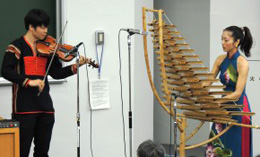
The room in Tama Campus that day had an atmosphere which made one feel as if they were in Vietnam. The air was filled with the sound of the trung, a traditional Vietnamese instrument. The music played by Kumiko Oguri, Japan’s foremost trung player, and violinist Takuya Morikawa had a soft, pure tone which produced a nostalgic yearning.
The trung is said to have come from an ethnic minority living in Thai Nguyen Province, a plateau region in central Vietnam. Unlike Japanese bamboos, those in Vietnam are thin. The trung is made of long bamboos whose joints are widely separated.
Afterwards, a lecture was given by Counselor Do Van Trung from the Embassy of the Socialist Republic of Viet Nam in Japan.
Competitive Entrance Examination
Similar to Japan, Vietnam uses a 12-year system of education. However, while Japan has 6 years of primary school, 3 years of junior high school, 3 years of high school and 4 years of university, Vietnam has 5 years, 4 years, 3 years and 4 years respectively.
There is fierce competition during entrance examinations in Vietnam. Children must take examinations to enter the 1st year of primary school. To pass the examinations, they must study without rest. As a former teacher, I believe that this is very difficult for young children.
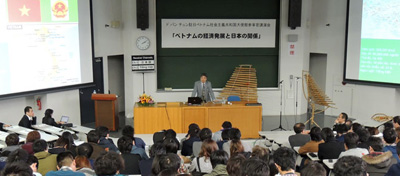
In my opinion, time spent playing and having fun is necessary for children to display their inherent cheerfulness. This is a concern for children living in Vietnam lacking this kind of time.
Currently, Vietnam has a respectable literacy rate of approximately 96%. There are approximately 13 million students and 804 thousand teachers from primary school to high school.
Furthermore, Vietnam has 1.55 million university students and 49,000 university instructors. There are also 1.45 million students and 25,000 instructors at junior colleges and vocational colleges. Compared to Japan, Vietnam has a high ratio of students compared to a single instructor.
At a primary school (focusing on preparing students for higher education) in Hanoi, there are about 55 to 60 students per teacher. Conversely, Japan’s goal for the next 5 years is a ratio of 30 students per teacher. This means that the number of students is twice as high in Japan. It will take time before Vietnam is capable of implementing an education like that of Japan.
There are many Vietnamese students studying abroad in Japan. This number has increased at a very high speed in recent years. A large number of Vietnamese students receive scholarships for Master’s Programs and Doctoral Programs. The number of government-sponsored foreign students has stabilized and there is an increase in self-financed foreign study by Vietnamese students.
Specifically, the number of self-financed foreign study in Japan has increased as follows: 810 in 2010, 1,111 in 2011, 3,110 in 2012, and more than 9,000 in 2013. Growth of the Vietnamese economy has increased household income and made foreign study possible.
Japan is chosen as a destination for foreign study because it has a good educational environment, a high level of education and an orderly society, and it is viewed as an appropriate country for cultivating the independent spirit of children.
Another reason for the increase in Vietnamese students is Japan’s relaxation of entry visas for Vietnamese nationals from July 2013. The number of Vietnamese foreign students is expected to increase even further in the future.
I hope that Japan will construct an environment in which Vietnamese children can receive education in Japan, eventually cultivating professionals who will contribute to the formation of Vietnam.
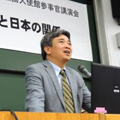
- Do Van Trung, Counselor, the Embassy of the Socialist Republic of Viet Nam in Japan
- Counselor Trung was born in Hanoi in 1957. He graduated from the Foreign Trade University in 1977. Mr. Trung studied in Japan for one year in 1990, and obtained a Masters degree in linguistics in 2000. He became a Lecturer at the Foreign Trade University from 1997 to 2010, and later appointed as Director of the Vietnam-Japan Human Resources Cooperation Center (JICA) from 2005. Currently Mr. Trung is Counselor and Director of the Bureau of Education and Training at the Embassy of the Socialist Republic of Viet Nam in Japan from July 2010.
Lecture: Current Society and Economy and Future Outlook in Thailand
Singtong Lapisatepun, Minister, Royal Thai Embassy, Tokyo
Approximately 600 years ago, the Ayutthaya Kingdom of Thailand interacted with the Ryukyu Kingdom. There are many interesting historical episodes involving the two countries. For example, the Japanese adventurer Nagamasa Yamada contributed to diplomatic relations and trade with Ayutthaya, being rewarded with a high position in Thailand. Furthermore, the Okinawan liquor awamori was introduced from Ayutthaya.
During the Meiji Period, while other countries in Southeast Asia were being colonized, Thailand engaged in diplomatic relations with Japan. These relations were part of King Chulalongkorn’s policy of modernization in order to resist pressure from Western countries. Relations between Thailand and Japan gradually grew warmer thanks to cultural similarities such as the Royal Household, Imperial Family, and respect for Buddhism.
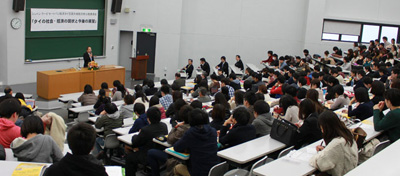
In 2011, Thailand was struck by severe flooding. Even so, approximately 7,000 Japanese corporations currently operate offices in Thailand. There are also approximately 40,000 Japanese employees stationed there. Bangkok has 2,300 students studying at schools for Japanese nationals, a large number second only to Shanghai and China.
The Japanese Chamber of Commerce in Bangkok is also the second largest organization in the world. From the perspective of Thailand, Japan is our most important partner in terms of imports and exports. Japan is also the largest source of foreign direct investment in Thailand. At the same time, Thailand fulfills an important role for Japanese corporations and the Japanese economy.
In 2012, 1.3 million Japanese tourists visited Thailand. Conversely, 260 thousand Thai citizens visited Japan in 2012. As of October 2013, 280 thousand Thai citizens have traveled to Japan.
Thai people are fond of Japan. This friendship has been enhanced now that a visa is no longer necessary to visit Japan, a policy enacted last year in response to a falling yen resulting from Abenomics. Another plus in relations is the direct airline flights connecting with 7 airports in Japan.
Despite language differences, there are 2,300 foreign students from Thailand in Japan. Overall, Thailand is ranked 6th in terms of foreign student in Japan. An incentive for studying in Japan is the prospect of employment at a Japanese corporation after learning the Japanese language and culture.
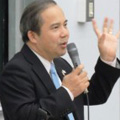
- Singtong Lapisatepun, Minister, Royal Thai Embassy, Tokyo
- Minister Lapisatepun was born in Chonburi Province, Thailand in 1962. He graduated from Tokyo Gakugei University Senior High School in 1983, and Yokohama National University Department of Economics Undergraduate Program in 1987. He completed the Master’s Program in Economy at Yokohama National University in 1989. Later he joined the Ministry of Foreign Affairs, Kingdom of Thailand in 1989. He served as Consul at the Consulate General of Kingdom of Thailand in Los Angeles from 1992 to 1996, and appointed Counselor of East Asia Department and Counselor of the Royal Thai Embassy, Tokyo before assuming his current position.
- Research Activities as a Member of Research Fellowship for Young Scientists (DC1), Japan Society for the Promotion of Science (JSPS) Shuma Tsurumi
- Important Factors for Innovation in Payment Services Nobuhiko Sugiura
- Beyond the Concepts of Fellow Citizens and Foreigners— To Achieve SDGs Goal 10 “Reduce Inequality Within and Among Countries” Rika Lee
- Diary of Struggles in Cambodia Fumie Fukuoka
- How Can We Measure Learning Ability?
—Analysis of a Competency Self-Assessment Questionnaire— Yu Saito / Yoko Neha - The Making of the Movie Kirakira Megane








